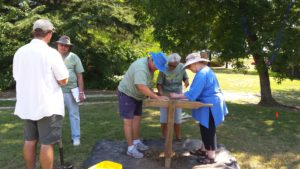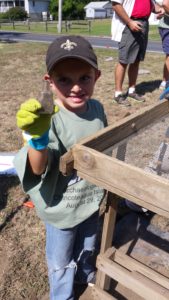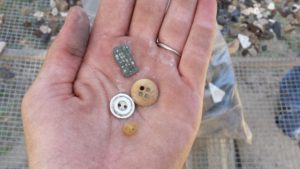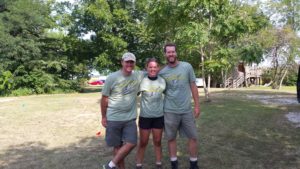There are many great reasons to take a trip to Chincoteague. This barrier island holding out against the Atlantic Ocean has its own storied history and unique culture, attracting visitors from far and wide who want to experience its solitude and seaside, its salt marsh and sunsets, and its quiet charm. We came for the archaeology!
Few visitors likely plan a trip to Chincoteague around its history, yet many discover there the Museum of Chincoteague Island and the Captain Timothy Hill House, getting a taste of the more complex stories that created the community we flock to now. We went a bit further and began to explore part of the island’s buried history, to help shed more light on the early settlers who decided to call this low-lying network of tidal creeks and sand dunes home. Our focus was on the original site of the Hill House. Limited testing done when the house was relocated revealed numerous artifacts related to the building and the families living within, but we wanted to get a better sense of the surrounding landscape. Were there other buildings located nearby? Did the Hill family have specific areas within the yard where they performed necessary household chores? Has there been much damage to the site from grading, utilities, or other activities? Was there a Native American presence on the land? Archaeological surveys can help answer questions like this, while at the same time give members of the public an introduction to the methods that archaeologists use to investigate sites.
The archaeological survey involved setting up a grid on the former site of the Hill House so that each test pit that we did would have coordinates linking them to the site map. Recording information about artifact location, depth, and associated soils allowed us to map and interpret the results during our analysis. The volunteers helped us dig small shovel test pits every 25 feet across the property and screen all the soil from each hole.

Volunteers help dig shovel test pits on a grid across the site.
We found artifacts almost immediately, including dozens of rusty nails, various bottle fragments, oyster shell, and burned coal. Most of this material appears to date to the late 19th and early 20th century, but the date was actually less important than the discovery. All the volunteers had a wonderful time plucking mysterious objects from the soil and then trying to figure out what they were. And since we rarely find anything complete, identifying objects from fragments is one of the hardest tasks. Some of the highlights that made everybody “ooh” and “aah” were a small painted metal toy canoe, a decorated metal pencil sharpener, as well as a complete Turlington’s Balsam of Life bottle. While the former weren’t the oldest artifacts, they opened a window into the lives of previous kids who lived on the site, and made some of our older volunteers reflect on whether they had played with similar objects when they were younger. Whether you have a serious interest in the past, a nostalgic connection to earlier times, or just a desire to discover something old, archaeology is something you should try.

A young archaeologist proudly displays the complete Balsam of Life bottle he just found in a shovel test.

Artifacts such as bone and shell buttons and a glass bead were also discovered in the shovel test survey.
If you enjoyed the digs last year, or you haven’t yet had the opportunity to get involved in archaeology, please plan to join us on Saturday, November 5th for an artifact washing activity at the museum. We will be washing some of the material excavated during last year’s dig, and having informal discussions about the types of artifacts we find and what they mean.
We have been conducting public archaeology programs for many years at sites primarily on Virginia’s Middle Peninsula. These projects can take many forms, but their overall goal is to investigate the past while involving members of the public in the process of discovery. The hands-on approach can be very effective at attracting people of all ages and getting them interested in history. The staff at the Museum of Chincoteague Island heard of these programs and invited us to come over to the Eastern Shore to conduct one here. They organized the process of soliciting volunteers and signing them up for several shifts during the day. The response to the project was fantastic, and we are truly grateful to the museum staff and volunteers who helped organize the day, and to the members of the public who worked with us.



My first Towles ancestor came ashore in the early seventeenth century and appeared on Chincoteague island.
I realise I missed my calling. I should have been an archeologist.
You still can!